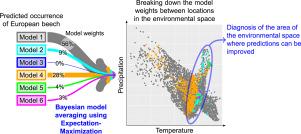Bayesian model averaging of climate-dependent forest models using Expectation–Maximization
IF 3.2
3区 环境科学与生态学
Q2 ECOLOGY
引用次数: 0
Abstract
In the context of rapid climate change, climate-dependent models are essential for assessing species vulnerability. However, variation in model structure and divergence in their predictions introduce substantial uncertainty. Rather than selecting a single “best” model, a more robust strategy is to integrate predictions across models. Bayesian model averaging with Expectation–Maximization (BEM) provides an alternative to simple model averaging (SMA) and weighted model averaging (WMA) for combining ensemble predictions. To date, BEM has been rarely applied to tree species distribution models. We developed a BEM framework for models predicting either species occurrence or proxy variables linked to occurrence. The approach was applied to European beech (Fagus sylvatica) in France, using an ensemble of six models: four species distribution models, one model predicting the probability of hydraulic failure, and one model predicting juvenile productivity. In contrast to SMA and WMA, which assigned similar weights across models, BEM concentrated 85% of the weight on two models. Furthermore, BEM enabled spatially explicit decomposition of model weights, allowing us to identify regions where predictions diverged most strongly. The resulting probability maps revealed a specific zone in environmental space where model agreement on beech occurrence was particularly limited. Focusing on this zone may help refine projections and shed light on the ecological mechanisms that enable local persistence.

基于期望最大化的气候相关森林模型贝叶斯模型平均
在快速气候变化的背景下,气候依赖模型对于评估物种脆弱性至关重要。然而,模型结构的变化和预测的分歧带来了很大的不确定性。而不是选择一个单一的“最佳”模型,一个更健壮的策略是集成跨模型的预测。贝叶斯模型平均与期望最大化(BEM)提供了一种替代简单模型平均(SMA)和加权模型平均(WMA)的组合集成预测。迄今为止,边界元法很少应用于树种分布模型。我们开发了一个BEM框架,用于预测物种发生或与发生相关的代理变量的模型。将该方法应用于法国欧洲山毛榉(Fagus sylvatica),采用6个模型:4个物种分布模型,1个预测水力破坏概率模型,1个预测幼树生产力模型。与SMA和WMA在模型之间分配相似的权重相比,BEM将85%的权重集中在两个模型上。此外,BEM支持模型权重的空间显式分解,使我们能够识别预测分歧最强烈的区域。由此产生的概率图揭示了环境空间中的特定区域,其中模型对山毛榉发生的一致性特别有限。关注这一区域可能有助于改进预测,并阐明使局部持久性得以实现的生态机制。
本文章由计算机程序翻译,如有差异,请以英文原文为准。
求助全文
约1分钟内获得全文
求助全文
来源期刊

Ecological Modelling
环境科学-生态学
CiteScore
5.60
自引率
6.50%
发文量
259
审稿时长
69 days
期刊介绍:
The journal is concerned with the use of mathematical models and systems analysis for the description of ecological processes and for the sustainable management of resources. Human activity and well-being are dependent on and integrated with the functioning of ecosystems and the services they provide. We aim to understand these basic ecosystem functions using mathematical and conceptual modelling, systems analysis, thermodynamics, computer simulations, and ecological theory. This leads to a preference for process-based models embedded in theory with explicit causative agents as opposed to strictly statistical or correlative descriptions. These modelling methods can be applied to a wide spectrum of issues ranging from basic ecology to human ecology to socio-ecological systems. The journal welcomes research articles, short communications, review articles, letters to the editor, book reviews, and other communications. The journal also supports the activities of the [International Society of Ecological Modelling (ISEM)](http://www.isemna.org/).
 求助内容:
求助内容: 应助结果提醒方式:
应助结果提醒方式:


